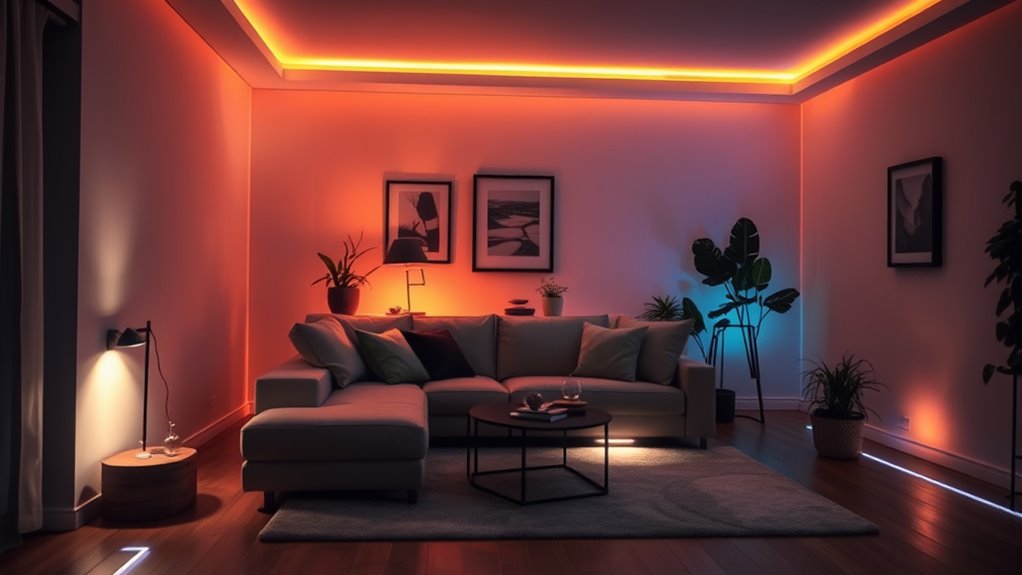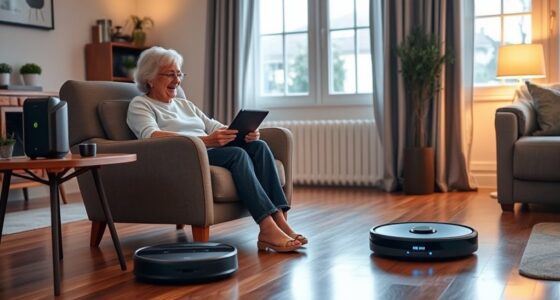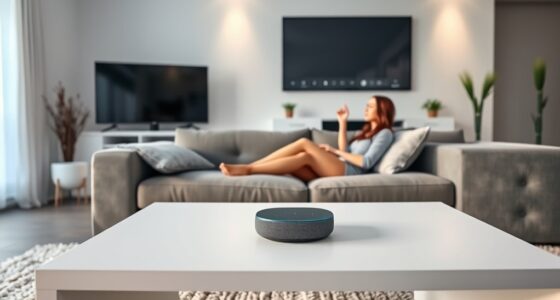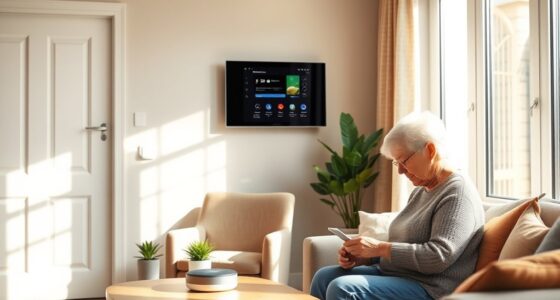To boost your mood and prevent falls, use smart lighting to adjust color temperature and brightness based on the time of day. Switch to energizing cool tones in the morning and warmer hues in the evening for relaxation. Implement motion sensors in hallways and bathrooms to guarantee safety during nighttime. Automating these features can create a comfortable, secure environment that lifts your spirits and keeps you safe—discover more ways to optimize your lighting setup as you continue exploring.
Key Takeaways
- Use warm, soft lighting in the evening to promote relaxation and improve sleep quality.
- Install motion sensors in hallways and bathrooms to automatically light paths, preventing trips and falls.
- Adjust color temperature throughout the day, with cooler tones in the morning to boost alertness and warmer tones in the evening for calm.
- Utilize dimming features during nighttime to provide gentle illumination that reduces fall risk without disturbing sleep.
- Incorporate smart scheduling to activate lighting gradually at sunrise and sunset, enhancing mood and safety automatically.

Ever wonder how to make your space both smarter and more energy-efficient? One of the easiest ways is to optimize your lighting with smart technology. Adjusting color temperature and incorporating motion sensors can notably boost your mood and help prevent falls, especially in areas like hallways, bathrooms, and staircases. When you choose lighting with adjustable color temperature, you can create the perfect ambiance for any time of day. Cooler tones, like bluish whites, energize you in the morning, helping you feel alert and ready to start your day. As evening approaches, warmer hues—soft yellows or amber—cozy up your space, promoting relaxation and better sleep. Smart bulbs allow you to switch seamlessly between these settings, so your environment adapts to your needs without manual effort.
Motion sensors are another game-changer. When integrated into your smart lighting system, they detect movement and turn lights on automatically, eliminating the need to fumble for switches in the dark. This is especially helpful in preventing falls—if you wake up at night or enter a room after dark, motion sensors ensure you’re greeted with sufficient, well-placed lighting, reducing trip hazards. Plus, sensors turn the lights off when no one is around, saving energy and extending bulb life. This automation not only enhances safety but also promotes a more sustainable lifestyle. You don’t have to remember to turn off the lights, and you won’t waste electricity lighting unoccupied rooms. Additionally, understanding potential risks associated with smart technology can help you implement appropriate security measures to protect your system from cyber threats.
Combining these features creates a dynamic environment that adapts to your daily routine. For example, during the day, your smart system can emit bright, cooler light to keep you energized. As evening nears, it switches to warmer, softer lighting, helping you wind down. When you get up in the middle of the night, motion sensors activate the lights at a low, non-intrusive level, guiding you safely through dark hallways. These small adjustments make a big difference in how you experience your space. They foster a sense of comfort, safety, and efficiency that traditional lighting simply can’t match.
Frequently Asked Questions
How Do Smart Lights Adapt to Circadian Rhythms?
Smart lights adapt to your circadian rhythms through circadian rhythm adjustment, syncing their brightness and color temperature with your natural sleep-wake cycle. They simulate natural light by gradually changing from cool, energizing tones in the morning to warm, relaxing hues in the evening. This helps regulate your internal clock, improving mood and sleep quality while reducing fatigue. You’ll find your daily routines more comfortable and aligned with your body’s biological needs.
Can Smart Lighting Reduce Energy Consumption Effectively?
While it might seem that bright, constant lighting is the norm, smart lighting proves otherwise. You can reduce energy consumption effectively by adjusting brightness and schedules, leading to significant energy savings. This not only benefits the environment but also offers cost benefits, lowering your electricity bills. Smart lights turn off automatically when not needed, making your home more efficient without sacrificing comfort or convenience.
Are There Specific Smart Lighting Features for Elderly Safety?
You can enhance elderly safety with smart lighting by using voice control, making it easy to turn lights on or off without fumbling in the dark. Remote access allows you to adjust lighting settings from anywhere, ensuring the environment stays safe and well-lit. These features help prevent falls and give peace of mind, especially for those with mobility issues. Embracing smart lighting creates a safer, more convenient home for seniors.
How Customizable Are Smart Lighting Schedules for Mood?
You’ll find that smart lighting schedules are highly customizable for mood, allowing you to adjust color preferences and timing. With scheduling flexibility, you can set different lighting scenes throughout the day to match your mood or activities. You can easily personalize brightness, color, and timing, ensuring your environment feels just right. This customization helps create a comfortable, uplifting atmosphere whenever you need it most.
Do Smart Lights Require Professional Installation or Easy Setup?
Smart lights are usually easy to set up, often requiring just a few installation tips like connecting to your Wi-Fi and downloading the app. You typically don’t need professional help unless you encounter compatibility issues with your existing fixtures or smart home system. Most models are designed for DIY installation, making it straightforward to get started. Still, check compatibility beforehand to avoid surprises and guarantee seamless operation.
Conclusion
Now that you’ve opened these smart lighting tricks, imagine your home as a well-lit sanctuary where mood swings are banished, and falls are a thing of the past. With just a flick of a switch, you can turn your living space into a cheerful, fall-proof fortress—no more accidental moonwalks in the dark. So go ahead, let your lights do the heavy lifting, and watch your worries fade as effortlessly as your dimmer switch.









